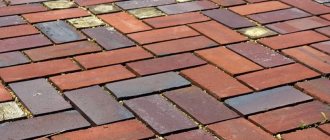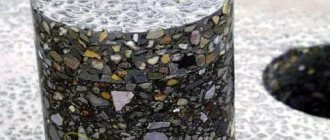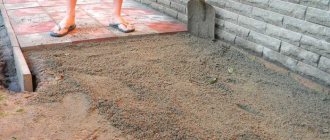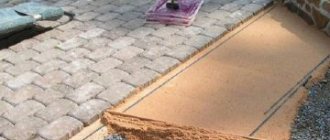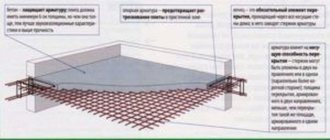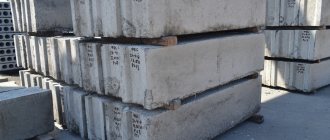Owners of land plots have a lot to do with landscaping: someone needs a parking area and convenient access to it, someone wants to organize paths or a blind area around the house. Different materials are suitable for the implementation of plans, but asphalt pavement is more accessible than others, and the technology of laying asphalt does not require special knowledge to apply it yourself. We figure out what features the technology has and how to lay the material yourself.
Cold asphalt area in front of the garage Source na-dache.pro
About technological features
Classic hot laying of asphalt pavement involves working with material heated to a high temperature. The method shows excellent results with large volumes of construction, but in everyday conditions it is irrational and quite dangerous.
Working with cold asphalt looks completely different; The installation technology has been simplified, but if the conditions are met, this does not affect the quality. The composition for “cold” work is prepared according to a modernized scheme. The product is specially designed to produce high-quality asphalt pavement at minimal cost; it has the following composition:
- Mineral filler. Crushed stone, sand, gravel and mineral powder are mixed in different proportions.
- Organic astringent. Medium or slow thickening petroleum bitumen.
- Modifying additives (they may not exist). Additionally, the composition includes polymer components (plasticizers) with adhesive properties.
Cold asphalt before starting work Source mount-blade.ru
Modifying additives are mixed with bitumen and increase its ability to envelop the filler and create a characteristic homogeneous structure during storage. Plasticizers are especially effective if bitumen with high elasticity and fluidity is used. Manufacturers offer material of different fractions: 2-5 mm, 5-10 mm, 5-20 mm.
Hot asphalt concrete gains strength as the preheated material cools. In contrast, the cold analogue becomes stronger due to the evaporation of hydrocarbons (a component of plasticizers). When the cold mix of asphalt concrete is compacted, the polymerization process begins, resulting in a hard, ready-to-use surface.
Compacted cold asphalt continues to gain strength under load, while maintaining elasticity and ductility. Therefore, it does not collapse during temperature fluctuations, although it responds with expansion to an increase in temperature and compression to a decrease.
Structure of a layer of cold asphalt Source googleusercontent.com
What is asphalt made from - the main components
Asphalt concrete is made at asphalt plants from bitumen and solid fillers. Artificial asphalt can include many other components depending on the purpose of the roadway and operating conditions.
- Coarse filler . This is crushed stone of various rocks or sedimentary rocks. Its purpose is to give the asphalt concrete pavement hardness and resistance to increased mechanical loads. A fraction of 10–40 mm is allowed.
- Fine-grained filler . The purpose of this component is to reduce porosity and increase the density of asphalt. To do this, quarry sand or crushed stone screenings are added to asphalt concrete. This filler improves the resistance of road pavements to high temperatures.
- Mineral powders . With their help, the viscosity of the mixture is adjusted.
- Bitumen . It is the main binding component of artificial asphalt. Some asphalt plants use other synthetic plasticizers, but this technology is more expensive and is only used for special road surfaces.
Advantages of technology and material
Cold asphalt technology has become widespread due to the following advantages:
- Year-round use. You can lay asphalt in any season, as long as the air temperature does not go beyond the range from -15 to +40°C. For all-weather material, the only limiter is precipitation (but this is undesirable for most technologies).
- Quick readiness for use. The mixture hardens and acquires the stated characteristics in 15-20 minutes. You can almost immediately put the car on a brand new site.
- Zero waste. If there is a remainder of the mixture that is not used for installation, it can be applied elsewhere. The old coating can be removed (milled) and reused in the road construction industry.
- Possibility of long-term storage. Without containers, the mixture can be stored for up to 1 year. In polyethylene containers, the material retains its quality for up to two years.
- Safety. The technology was developed to be environmentally friendly; there are no hot processes. Adhesive plasticizers are inert substances that do not emit harmful volatile compounds.
Road patching Source inforum.com
- Easy transportation. Manufacturers package the mixture in buckets (25 kg each) or bags (50 kg each). A small truck or the trunk of a car is suitable for transportation.
- Mobility and high speed of work. The technology does not require additional operations, such as heating pits and processing edges in classic pothole repair; no need to use heavy equipment. All you need to do is clear the pits of debris. Thanks to the reduction in preparatory operations, work is carried out 1.5 times faster.
See also: Catalog of construction companies that have their own production of materials and components for the construction of houses
Types of inert materials
Inert materials are extracted during quarrying, as well as through the processing of various rocks. They are dense and porous, differing in the size of the fractions. In fine-grained materials, the fraction size does not exceed 5 mm. The scope of application depends on their technical features. Inert building materials are solid non-combustible minerals:
- Gravel is a rock containing inclusions of other types of minerals, differing in the size of the fractions.
- Crushed stone is a rock with a fraction size of 5 mm, obtained by crushing.
- Sand is a bulk material with small fraction sizes, mined in river floodplains and quarries.
- Expanded clay is a bulk material with fractions that have a porous structure, produced artificially by firing clay or shale.
You may be interested in: A specialized organization is... Concept, rights and powers
Inert materials are inexpensive building materials. These also include all inorganic natural resources, including chalk, clay and shell rock. They are used on construction sites in large quantities and help reduce construction costs. Special equipment is used for extraction.
Cons of the mixture
The technological accessibility and all-weather capability of the technology exceeds its following disadvantages by a margin:
- Due to the inclusion of plasticizers in the composition, the cost of the mixture (compared to traditional asphalt) is two to three times higher. The difference does not greatly affect the improvement budget; in private households, the technology is used to a limited extent.
- Water and dirt affect quality. If you choose to lay cold asphalt, be sure to thoroughly dry and clean the surface from dirt (especially important when laying it manually).
- A coating made from such a mixture does not withstand constant loads at high (summer) temperatures.
Asphalting the area in front of the gate Source grounde.ru
Basic principles of pavement structure design
Designing the composition of an asphalt concrete mixture consists of calculating the optimal ratio of components, as a result of which the indicators of the main characteristics of asphalt concrete of a given type and corresponding grade will meet the technical standards and requirements of GOST 9128-13.
Method for determining the grain structure of asphalt
Various methods for designing asphalt concrete compositions have been developed and used.
In modern construction, the most common method for constructing limit curves of the grain structure of the mineral part of road concrete (see photo), which is based on the following instructions:
- In order to ensure the strength, economy and durability of the coating, its mineral component must have sufficient density, which is ensured by a certain content of coarse and fine grains in the overall composition of the fillers.
- The structure of the grain part is limited by the limit curves of the permissible amount of a given grain fraction.
- The minimum bitumen content must correspond to the physical and mechanical properties of asphalt concrete of the required grade, taking into account the technical requirements of GOST 9128-13. The optimal volume of the component is established experimentally based on tables and graphs of tests performed.
Setting the design parameters of the mixture
The composition design process consists of the following stages:
- determining the characteristics and quality of the initial components, assessing their suitability for a given brand;
- calculation of the mineral part from selected materials;
- determining the rational amount of bitumen;
- specification of the composition of the mixture according to a detailed study of its physical and mechanical qualities.
A necessary condition for designing a composition is a reasonable and accurate technical specification.
To draw up technical specifications, you must have the following construction, design and operational data:
- design design of the road pavement indicating the thickness of the layers of all coatings;
- technical category of the road;
- characteristics of the traffic mode of road transport on the designed road section;
- expected changes in road and climatic conditions during the construction and operation of the facility.
- balanced characteristics of all available starting materials.
Areas of application
In addition to restorative pothole repairs on roads and parking lots, cold asphalt concrete is used in the following cases:
- Construction of a blind area in private housing construction.
- Construction of artificial ascents and descents.
- Framing road hatches, drainage grates and other metal elements on the canvas.
- Flat roof waterproofing.
- Filling potholes, cracks and expansion joints on the road.
- Laying garden paths and areas on private property.
Laying asphalt mixture around the hatch Source duna-spb.ru
Methods of laying asphalt
Cold paving
In cold asphalting, the mixture is based on liquid petroleum road bitumen. The peculiarity of the work is that installation is possible only in the warm season. This is because the water drying step is not used. This paving method is well suited for pothole repair.
Hot paving
During hot asphalt paving, the main components of the mixture are liquid and viscous petroleum bitumen. The peculiarity of installation is that work can be carried out in winter, when it is cold outside. In order for the asphalt coating to be durable, the temperature of the asphalt during laying according to GOST must be at least 120 degrees . The area where asphalt is planned to be laid is pre-dried using special equipment.
Do-it-yourself installation instructions
The technologically unpretentious mixture has gained popularity among owners of private households. The use of the finished mixture is regulated by the rules of GOST 11-10-75. It is prohibited to be used on main roads (only for repairs), but it is permitted to be used for repairs or construction on personal property.
Cold asphalt adheres reliably to any surface (concrete, asphalt, brick, crushed stone). When developing a private territory, the asphalt concrete laying technology goes through the following stages:
- Preparation. The finished mixture is purchased in convenient packaging: bucket (30 kg), bag (25 kg), big bag (soft container, 1000 kg).
- At the site where the path is supposed to be, the fertile layer of soil (up to 10 cm) is removed. The excavation is filled with sand and gravel to half its height, and the layer is compacted. Using a gravel-sand mixture allows you to save on more expensive cold asphalt.
- If a site is being developed, geotextiles (density 300-400 g/m²) are laid on the leveled surface, which will prevent the upper layers from sagging. Crushed stone 15-20 cm thick is poured on top (a fraction of 2-20 mm is suitable). For compaction, it is better to use a vibrating plate or vibrating roller.
Laying cold asphalt with a manual roller Source kafmt.ru
- For the path, two layers of cold asphalt are laid (2-3 cm each). The layers are compacted with a hand roller.
- The site is also backfilled and compacted in layers. Tamping is considered complete when the vibrating plate stops leaving a mark. To prevent the material from sticking to the tool, use water.
- Completion. After compaction, the path is sprinkled with water and left for a day to gain strength. The edges of the site are coated with bitumen mastic (to preserve the geometry), the surface is covered with a cement-sand mixture. This measure will prevent asphalt from sticking to your car wheels and your shoes.
Water prevents the asphalt mixture from sticking Source thebalancesmb.com
What equipment is used when paving roads?!
All the equipment presented above is used when paving roads. To properly lay asphalt and give it strength and durability, you need to carefully follow all the stages of laying the pavement and use specialized equipment. Only a heavy machine is capable of compacting layers of asphalt concrete pavement well in order to minimize voids and provide the road surface with high density.
High-quality step-by-step execution of all work guarantees the coating high performance properties and a long service life.
Ours offers you rental services for a soil vibratory roller and other special equipment needed at different stages of work on laying a new road surface at low prices. We also offer supplies of inert materials to construction sites.
Call now and get a discount or send a request to This email address is being protected from spambots. You must have JavaScript enabled to view it.
Video - Correct asphalt laying technology
Video – Modern asphalting technologies
Features of autumn and winter technology
When the temperature tends to zero and goes into minus, cold asphalt reduces plasticity, which can negatively affect the final quality. Therefore, it is recommended to prepare the material as follows:
- Before starting work, the bags of asphalt are kept in a heated room for at least two days. A temperature of at least +10°C will preserve the quality of the composition.
- Before use, cold asphalt is slightly loosened.
- The material itself and the installation site are heated (conveniently, for example, with a gas burner).
Asphalt path in front of the house Source na-dache.pro
Certain types of asphalt concrete mixtures
In addition to traditional and widely used asphalt concrete mixtures, there are more advanced road materials that differ from the former in composition and laying conditions.
These include:
- ShchMA crushed stone-mastic mixtures with stabilizing additives.
- Cast asphalt concrete mixtures with an increased content of bitumen and mineral powder.
- Polymer-asphalt concrete mixtures with the addition of polymers (elastomers).
- Colored hot and cold mixtures with coloring pigments.
- Glass-asphalt concrete mixtures containing broken glass.
- Rubber-asphalt concrete and rubber drainage mixtures with rubber crumbs and polymer additives.
- Sulfur-asphalt concrete mixtures with the presence of technical sulfur.
Each type of material has a specific area of application, determined by the characteristics and performance properties of the resulting coating.



